UTI Multi Asset Allocation Fund: One of most consistent multi asset allocation funds

Current market context
Volatility returned to market after Trump Administration imposed 50% tariff on India's exports. Talks between President Trump and President Putin on the Ukraine War remained inconclusive. There is uncertainty about the impact of tariffs on India's exports, even as the Government is trying to negotiate bilateral trade agreements with other countries. In an environment of economic uncertainty, a multi asset allocation strategy can bring stability to your investment portfolio.
What are multi asset allocation funds?
Multi Asset Allocation funds are hybrid mutual fund schemes which invest in 3 or more asset classes. According to SEBI regulations multi asset allocation funds must invest minimum 10% each in at least 3 asset classes. Apart from the two most popular asset classes, debt and equity, these schemes invest in asset classes like gold, silver, international securities, real estate investment trusts (REIT), infrastructure investment trusts (InvITs) etc.
In the last couple of years, quite a few multi asset allocation funds have been launched. As per AMFI data the assets under management of this category grew by nearly 43% in the last 1 year (as on 31st July 2024). In this article, we will review UTI Multi Asset Allocation Fund, which has been one of the most consistent multi asset allocation funds.
Why multi asset allocation?
- Different asset classes have low or even negative correlation of returns in different investment cycles (see the chart below). Diversifying your investment across asset class will bring stability to your portfolio and improve consistency i.e. if one asset class underperforms, the outperformance of another asset class will balance the risks.
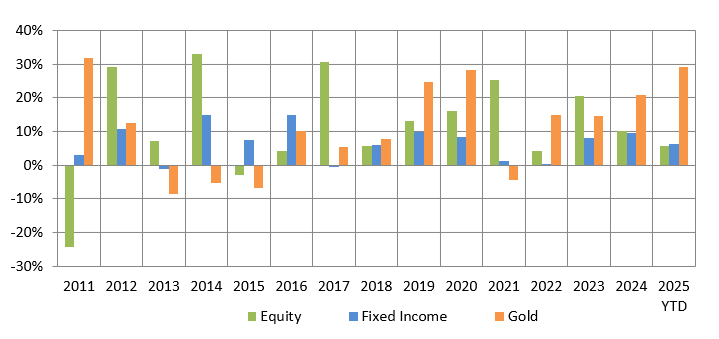
Source: Advisorkhoj Research, NSE, MCX. Equity is represented by Nifty 50 TRI, Fixed Income by Nifty 10 year Benchmark G-Sec Index, Gold by MCX spot prices. As on 31st July 2025
- Historical data shows that gold as an asset class outperforms equity in times of market downturns. Multi asset allocation can provide richer diversification to your investment portfolio.
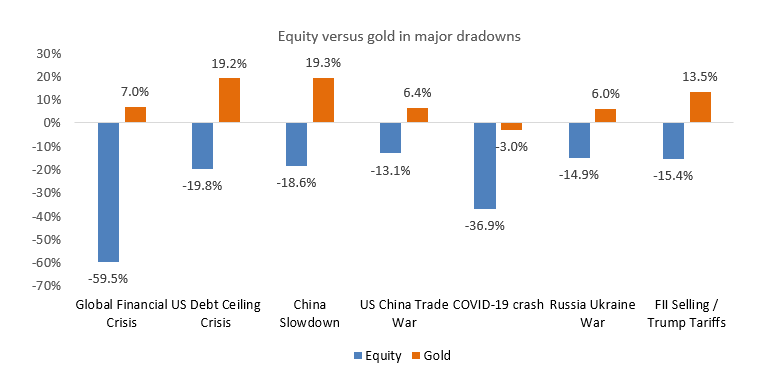
Source: Advisorkhoj Research, NSE, MCX. Equity is represented by Nifty 50 TRI, Gold by MCX spot prices. As on 31st July
UTI Multi Asset Allocation Fund - Asset Allocation Strategy
For Equity (net long exposure: 40%-80%)
- 1Y forward Price to Earnings (PE) Ratio - Higher the P/E ratios, lower the equity allocation.
- TTM* Price to Book (PB) Ratio - Higher the P/B ratios, lower the equity allocation.
- TTM* Dividend Yield - Higher the dividend yield, higher the equity allocation.
- Yield Gap - Yield gap is difference of Equity Yield (1/1 year Forward Nifty 50 P/E Ratio) and Bond Yield (10-year GSEC Yield). Higher the yield gaps relative to history, higher the equity allocation.
For Gold (10%-25%)
For gold allocation the model assesses the Gold/Equity (G/E) Ratio which is based on historical trends since 1999. When G/E Ratio is below mean, the allocation to Gold is higher and vice versa.
Fixed income (10%-25%)
The Residual Allocation goes to fixed income through exposure in high rated debt and money market instruments.
Outperformed peers
The chart below shows the 3-year rolling returns of UTI Multi Asset Allocation Fund versus the multi-asset allocation fund category over the last 5 years. You can see that the fund has consistently outperforming the category average for most of this period.
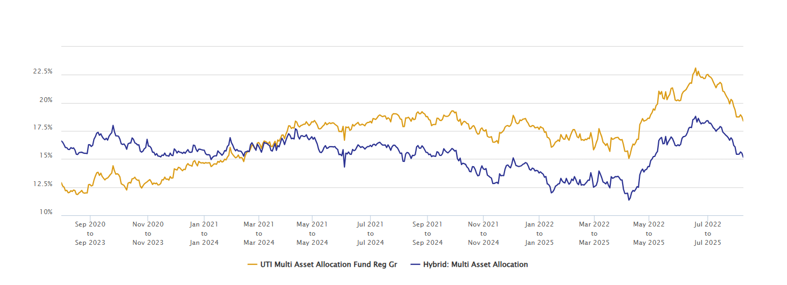
Source: Advisorkhoj Research. As on 14th August 2025
Strong performance consistency
The chart below shows the 3-year rolling return distribution of UTI Multi Asset Allocation Fund over the last 5 years. You can see that the fund gave 12%+ CAGR returns in 98% of the instances (observations).
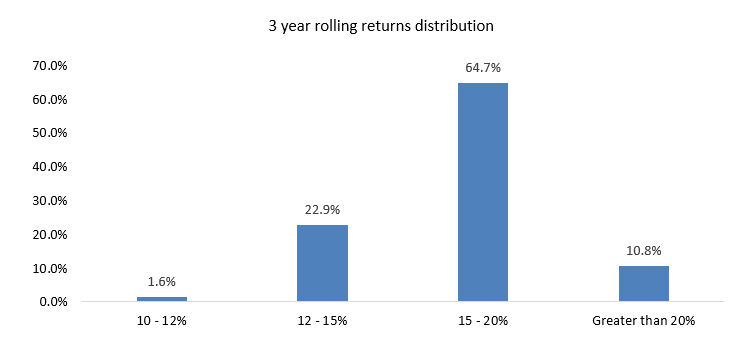
Source: Advisorkhoj Research. As on 14th August 2025
Consistently in top quartiles
UTI Multi Asset Allocation Fund has figured in the Top 2 quartiles in 7 times in the last 12 quarters.

Source: Advisorkhoj Research. As on 30th June 2025
Limited downside risks for investors
The chart below shows the drawdowns of the fund versus the broad market index since 2020. You can see that the fund was able limit downside risks for investors.
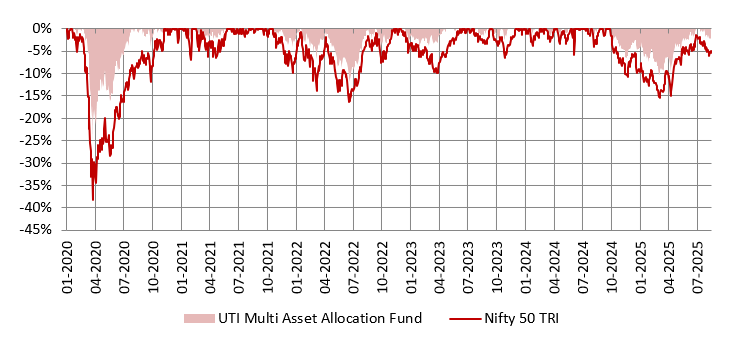
Source: Advisorkhoj Research. From 1st January 2020 to 14th August 2025
UTI Multi Asset Allocation Fund - Portfolio Positioning
The gold allocation is towards the lower end of the range, which is sensible because gold prices have been risen more than 70% in the last 2 years. In the equity portion the fund has a large cap bias which is prudent in current market conditions
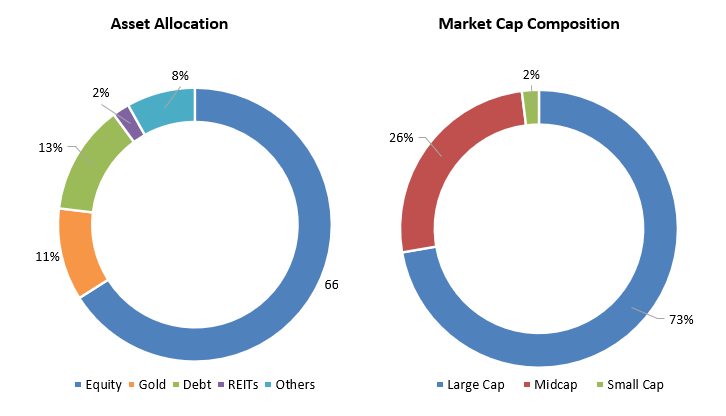
Source: UTI MF Fund Factsheet, as on 31st July 2025
Why invest in UTI Multi Asset Allocation Fund?
- Asset allocation may reduce portfolio volatility and provide stability to your portfolio at volatile markets.
- The fund provides exposure to 3 asset classes with an aim to provide better risk adjusted returns.
- Benefit from equity taxation. The fund will endeavour to maintain equity allocation at minimum 65%.
- The fund is a one stop solution which may help to reap benefit of Growth of Equity, Stable returns of Debt & Diversification from Gold.
Who should invest in UTI Multi Asset Allocation Fund?
- Investors looking for capital appreciation over long investment horizons.
- Investors who want to reduce portfolio volatility by diversifying across multiple asset classes.
- Investors with minimum 3 - 5 years investment tenure.
- Investors with high-risk appetites.
- You can invest either in lumpsum or SIP based on your investment needs.
Investors should consult their financial advisors or mutual fund distributors if UTI Multi Asset Allocation Fund is suitable for their investment needs.
Mutual Fund Investments are subject to market risk, read all scheme related documents carefully.
Queries
-
What is the benefit of mutual fund STP
Aug 29, 2019
-
How much to invest to meet target amount of Rs 2 Crores
Aug 26, 2019
-
Can I achieve my financial goals with my current mutual fund investments
Aug 24, 2019
-
Can you tell me return of various indices
Aug 19, 2019
-
What would be the post tax return on different investments
Aug 18, 2019
-
Which Principal Mutual Fund scheme will be suitable for my retirement corpus
Aug 16, 2019
-
What is the minimum holding period for availing NCD interest
Aug 4, 2019
Top Performing Mutual Funds
Recommended Reading
Fund News
-
Mr. Navneet Munot's 'Person of the Year 2025'
Dec 31, 2025 by HDFC Mutual Fund
-
Zerodha Mutual Fund launches Zerodha Nifty Short Duration G Sec Index Fund
Dec 26, 2025 by Advisorkhoj Team
-
Groww Mutual Fund launches Groww Nifty Chemicals ETF
Dec 26, 2025 by Advisorkhoj Team
-
DSP Mutual Fund launches DSP Nifty Next 50 ETF
Dec 19, 2025 by Advisorkhoj Team
-
DSP Mutual Fund launches DSP Nifty 500 Index Fund
Dec 19, 2025 by Advisorkhoj Team














